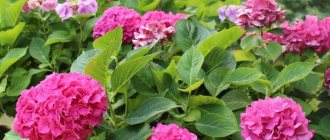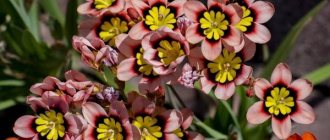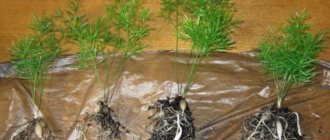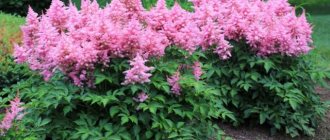Lagerstroemia or Lagerstroemia is a genus of about 50 species of flowering, deciduous or evergreen trees and shrubs that grow naturally in Southeast Asia, northern Australia and the islands of Oceania.
Lagerstroemia received its name in honor of Magnus von Lagerström, a Swedish merchant who was one of the main suppliers of plants to the famous naturalist Carl Linnaeus.
In garden culture, of all species, Indian lagerstroemia (Lagerstroemia indica), also known as Indian lilac, has become widespread.
In its homeland in China, it was known thousands of years ago and was especially loved by representatives of the Tang dynasty, who ruled from 618 to 906 AD.
This species is characterized by compactness, high decorativeness and is the progenitor of many highly decorative garden hybrids.
Description
The ornamental garden plant Lagerstroemia indica grows well in the Mediterranean, in the south of Ukraine and Russia. A deciduous shrub or tree is covered with many “corrugated plates” of various colors and shapes, collected in dense tassels.
The leaves are simple, with full margins, different sizes 5–20 cm, oval, elliptical. In autumn, the green leaves turn gold, orange, red or purple before falling. Some varieties have dark burgundy and even almost black leaves.
The flowers are 2.5 cm in circumference, with wavy edges, and are a panicle of ruffled flowers with a crepe texture. The colors are white, pink, raspberry, lilac, red and almost every shade in between. While there is no such thing as orange, yellow or pure blue, there is still a tendency towards the blue end of the spectrum.
Lagerstroemia grows well in the southern regions of our country
Lagerstroemia lilac has a wiry, grooved stem and spotted branches due to peeling bark. In Crimea, it can withstand frosts down to -10°C, provided that the shoots have time to become lignified. In hot, dry summers, the plant needs to be watered regularly. Grows best in fertile, well-drained soils and does not tolerate salinity. Tall trees reach 25-30 meters.
Sometimes lagerstroemia grows to the size of a tree
All diversity is divided into:
- Species: Inflorescences are looser than those of varietal ones. The leaf is long, oblong, pointed. The crown is branched. The smooth light bark of the trunk resembles coffee with milk.
- Varietal: with oval leaves and dense, dense inflorescences of rich colors. For example: Red Rokket - with bright scarlet inflorescences.
Cherry Dazzle - translated as dazzling cherry, also red. Short. The leaves are small, bronze, then darken, turn green, and turn red in the fall. Small flowers with round frilly petals are collected from pink and red inflorescences.
The crown of the variety is dense, self-branching. The branch, stopping in growth, sends out shoots from all the axils, and the plant turns out to be as thick as a Christmas tree. And it is noteworthy that each one grows with a bend to the side. The variety is not afraid of disease and drought.
Lagerstroemia Cherry Dazzle
Lagerstroemia indica or Indian lilac: winter-hardy varieties
Fragrant flower matthiola bicorne: how to grow a fragrant plant
Remember that frost resistance is conditional: this means the lowest temperature that plant roots can withstand, provided there is good winter shelter. The ground part is damaged already at -5,-10°C.
Indian lilac variety Cherry Dazzle photo
Cherry Dazzle - a low-growing shrub that demonstrates resistance to diseases and pests. Young leaves have a bronze tint, then turn green and turn purple in the fall. Pink or red flowers last from May until the end of June. Winter hardiness zone 6a-10b (withstands short-term frosts down to -23°C).
Indian lilac variety 'Cordon Bleu' photo
Cordon Blue is a low-growing shrub that blooms from May to the end of June. The corollas have a lilac-blue hue; they gather in loose cloud inflorescences of various shapes. The leaves are oblong, dark green, turning yellow in autumn. Winter hardiness down to -17°C.
Indian lilac Dynamite Lagerstroemia indica 'Dynamite' photo
Dynamite is a shrub or tree 3 m high. The branches and shoots are covered with smooth gray-green bark. The dense, dark green leaves turn yellow in autumn. The petals are corrugated, their color is fiery red. The flowering period occurs in May-June. Winter hardiness zone 7A - 9B (withstands frosts down to -17°C).
Indian lilac variety White Chocolate photo
White Chocolate is a medium-sized bush about 3 m high. Branching is active. The bark is smooth and light brown. The leaves are small with slightly wavy edges and have a bronze-green tint. Lush panicles are formed by snow-white corollas. The flowering phase occurs in May-June. Places with bright sunlight are suitable for planting. Winter hardiness zone 7-9 (withstands frosts up to 15°C).
Lagerstroemia variety Light pink photo
Light pink is a small tree or shrub ideal for both gardening and container growing. During flowering (May-June), the dark emerald leaves are almost hidden by caps of light pink inflorescences.
Indian lilac Purple Magic photo
Lilac purple is one of the popular varieties of Indian lilac. This is a medium-sized shrub with smooth dark brown shoots. The emerald leaves are slightly curved. Purple inflorescences adorn the bushes in May-June.
Indian lilac Red Filli photo
Red Filli - shrubs of medium height. The leaves are glossy, emerald green. The dense panicle of the inflorescence is formed by small coral flowers. Winter hardiness zone 5b (withstands frosts down to -26°C).
It is worth mentioning the varieties Red Rokket with pink flowers, Zuni with lilac inflorescences, two-color Berlington.
Indian lilac variety Lagerstroemia indica 'Victor Dwarf' photo
Victor Red is a dwarf variety that grows to about 1.2m tall and wide, making it an excellent choice for small garden spaces. In summer, the upright, rounded shrub is covered in dark red flower clusters. In fall, the foliage turns into a bright orange-red bonfire. After the leaves have fallen in the fall, the peeling bark provides interest during the winter months. Winter hardiness zone 7-9.
Victor Red is a dwarf plant that fits perfectly into small gardens and spaces. Suitable for containers. Planted solo, in small groups or as a colorful hedge.
Types and applications
There are more than 25 species. Most grow in China, Korea and Japan. Lignified branches are super-strong and hard raw materials; they are used to make furniture and railroad ties. In its climatic zones, the plant is distributed in various types of landscapes; The leaves are used to feed larvae in the production of valuable Toscara silk.
Indian
The most common type, the shoots are thin, with a shiny, glossy skin. The leaves on the branches are attached to small cuttings. They are dark olive, dense, have a fleshy structure, round closer to the stem and pointed in the other direction. During flowering, they are practically invisible behind the lush inflorescences.
The inflorescences of densely growing flowers resemble a 20 cm pyramid. The buds resemble balls and gradually bloom from the bottom. In a flower of several wavy petals with a fringe of eyelashes, it blooms into a double miracle, reminiscent of a miniature rose. Bright yellow stamens are visible in the middle. The lush splendor of different flowers shower the bush. Has high adaptive abilities.
Lagerstroemia indica
Guilinensis
The shoots are thin and smooth. The leaves are small, rich green, shiny, about 6 cm. The leaf is wedge-shaped or rounded, the apex is pointed. The petals are one and a half centimeters white and grows on limestone mountain soil.
Lagerstroemia Guilinensis
Felt (tomentosa)
The branches are covered with a gray, fibrous layer of bark. Shoots and leaves have golden skin. The leaves are glossy and pointed. The petals are round, the color varies from white to pink and purple.
Tailed
The branches are smooth, with widely scattered leaves. They are located on legs measuring from five millimeters to a centimeter. The leaves are oval or elliptical, can be either bare or pubescent on the outside, up to 5 cm in size. The leaves are the same shape as the previous variety. The sepals are small, with a glossy surface.
Petals are white, oblong (1 cm). It blooms and produces fruits from early April to late October. This species is found in forests, forest edges, and hills. Other popular varieties of Lagerstroemia: Cordon Bleu, Dynamite, White Chocolate, Light Pink, Graceful Banaba.
All species need warmth, watering, good insolation and regular feeding. To give beautiful lines to a bush or tree, pruning should be done once a year. Domestic species urgently need a warm winter.
The inflorescences of caudate lagerstroemia are collected in peculiar tassels (tails)
LiveInternetLiveInternet
—Categories
- 3D, fairies and more (326)
- Watercolors (565)
- animation (63)
- blogs (27)
- everyday life (436)
- videos (92)
- Video tutorials (51)
- Everything for photos (4)
- knitting for children (509)
- crochet (232)
- knitting (1149)
- Gimp (8)
- glitters (11)
- Cities and everything (199)
- Girls (340)
- decoupage (118)
- Children's illustrations (336)
- for blog (161)
- blog frames (424)
- for garden (1372)
- genre (367)
- It's a shame for the State (208)
- Health (845)
- Toys, crafts (246)
- Games (9)
- Interesting (306)
- History (108)
- cacti (97)
- Brushes (50)
- Clusters (234)
- clipart (1082)
- Blog Buttons (1)
- Corel (30)
- Space (114)
- Creative art (58)
- dolls (183)
- paper dolls (19)
- rag dolls (112)
- Cooking (568)
- kitchen (472)
- modeling (12)
- Faces of the Gods (159)
- Literature, fairy tales (105)
- People (27)
- masks (48)
- Fashion, style (132)
- Mine for Photoshop (3)
- My hobby, crafts (15)
- My collages, congratulations to friends (44)
- my works (59)
- My city is Ufa (38)
- Music (51)
- need to know (8)
- Inscriptions, comments (53)
- still lifes (382)
- still lifes - photos (139)
- Postcards (164)
- Paint (7)
- Gifts for me (11)
- portraits (815)
- holiday fast (136)
- omens (218)
- Nature (210)
- programs (154)
- Frames (116)
- Drawing (70)
- Painting (242)
- salon (4)
- Scrap - children's (80)
- Scrap - winter (191)
- Scrap-fairy tale-fantasy (145)
- Scraps (593)
- Scraps - spring (52)
- Scraps - summer (191)
- Scraps - sea - beach (108)
- Scraps - autumn (136)
- Sculpture (196)
- Is it funny (9)
- styles (54)
- Poems in frame (182)
- Jewelry, stones (88)
- Lesson (320)
- photoshop lessons (239)
- fantasy (357)
- porcelain (222)
- Fauna (336)
- filters (14)
- flora (626)
- backgrounds (507)
- Photo-Art (346)
- artists (1060)
- Flowers (942)
- Other people's works (133)
- sewing (376)
- font (41)
Reproduction
- The seeds are sown in moist soil to a depth of about a centimeter and covered with a glass or film cap. This is done at an ambient temperature of at least 24 ° C, and full sunlight is also needed. Periodically needs watering and ventilation.
After two weeks, sprouts will appear from the soil. Afterwards they are planted in pots. Sprouts obtained in this way lose their varietal qualities during cross-pollination, so Lagerstroemia seeds must be purchased in specialized stores, research institutes, and private breeders.
It is possible to grow lagerstroemia from seeds
- Cuttings are separated in the spring. The lignified shoot is cut from the trunk and placed in a mixture of peat and sand. Several branches are planted in a pot at once. The dishes with cuttings are covered with a transparent bag and ventilated from time to time. The first roots will appear within 20 days.
- Division. Basal shoots are separated from the mother plant in the spring during replanting. The main thing is that he has already acquired his own roots. Planted in a light substrate, slightly moistened and placed in a warm, shaded place. When the plant gains strength, it is transferred to a permanent place.
Home care
Lagerstroemia requires careful care, otherwise the flowering will be weak and short-lived. In addition, the pet needs rest - if it does not shed its leaves, it will not gain strength by spring. Compliance with the watering regime is one of the most important conditions for caring for Indian lilacs.
You can’t overdry it, otherwise it will drop its buds, and if you don’t water it for a long time, it will drop its leaves. And vice versa, in the case of flooding, mold appears, which is harmful to the plant. It is recommended to water once a day, and twice in the summer, spraying if necessary. When the growth period ends, watering is reduced.
In winter, maintain soil moisture so that it does not dry out. When the plant is watered, it is transferred to a warm place for one to two hours. You need high-quality water, soft and free of impurities. If possible, the water is filtered; if not, it is recommended to stand.
If the air in the room is dry, the foliage is sprayed every day, in the morning or evening. The procedure is carried out during the cold period, if the plant has not lost its leaves. During the period of growth and development, room temperature is ideal for the oriental beauty. In winter, you need coolness, about 10 ° C.
An insulated loggia or veranda on the southeast and southwest sides is well suited - the plant needs a lot of light. In the shade, the shoots will stretch out and flowering will deteriorate. Lagerstroemia tolerates short-term frosts down to -5°C on the balcony and up to -10°C outside.
Trimming
The tree grows quickly, and inflorescences appear only on young branches. Therefore, pruning is done every year in the fall. The shoots are cut to 20–30 cm. If the plant is a tree, one developed shoot from the root is left, the others are removed. If a shrub is formed, there are several main shoots. Damaged, broken off, growing inward and thickening the crown are also removed.
Soil and fertilizing. Grows well in store-bought, all-purpose potting mix for flowering plants. The drainage layer is a quarter of the total volume. It is possible to create the soil for planting yourself - equal proportions: sand, turf and deciduous soil. The substrate must be loose - this is important! Fertilizers are applied during the period when the plant blooms. In the spring, liquid complex fertilizer and fertilizing are applied.
Transfer. On average, the plant is moved to another container in the spring every 2 to 3 years. The container for transplantation should not be too large, but high enough. A gentle way is to reload or renew the top layer of soil (it does not tolerate the procedure well).
Landing technology
The plant is grown in open ground only in the southern regions; in more severe climates it dies. In the temperate zone, it is cultivated in a greenhouse, greenhouse or at home.
Variety selection
Varieties are selected depending on the region of future growth. Ideal for cultivation in open ground are climatic zones 8 and 9, i.e. areas with long summers and mild winters - the temperature does not drop below –15°C. These are the southern regions of Russia and Ukraine.
Recently, American Filli hybrids (Red Filli, Coral Filli and Violet Filli) appeared on sale, intended for climate zone 4 with winter temperatures down to –32°C. A low-growing species, the height of which does not exceed 50 cm, is distinguished by its very early flowering. It grows well and manages to bloom in open ground in the Voronezh region.
Red Filli
Soil preparation
The plant is undemanding to soil, but prefers to grow on nutritious, light and loose soil. It will be suitable for universal soil, purchased in a store, but always intended for flowering plants.
Or prepare the soil yourself from the following components, taken in equal proportions:
- turf land;
- deciduous soil;
- peat;
- sand.
Choosing a place for planting in open ground
In the garden, choose a sunny place with direct sunlight. The plant is not afraid of burns and overheating, because the air outside constantly circulates. A little partial shade is allowed, but this affects flowering. It will not be as lush and plentiful.
Lilac bush on the site
Planting a plant
When planting a seedling in a permanent place, its main root is shortened by half. Dig a planting hole measuring 40x40, 50x50 cm. It should be twice the size of the root system. Fill it with fertile soil, deepening the root collar 8–10 cm below ground level.
In the first year, fertilizers are not applied, as it is necessary for the plant to build up its root mass. Fertilizing stimulates green growth and flowering.
Diseases, pests and problems
The eastern beauty is sick and rarely exposed to pests. The main pests for the plant are aphids and red mites. There is still a risk of exposure to mold and powdery mildew indoors. This is where fungicidal preparations come to the aid of gardeners. For preventive purposes, you need to regularly ventilate, water, and use a ventilated substrate.
Problems of gardeners when growing:
- Insufficient number of flowers and stretching of shoots due to lack of light, low temperatures, lack of rest in winter;
- Improper pruning will not produce inflorescences;
- Falling leaves and flowers in summer means lack of moisture;
- If it died, it was due to excessive watering, dry soil, or low temperatures.
Beneficial features
Organic composition
Experts studying the composition of the plant in laboratories have come to the conclusion that lilac petals contain essential oils, ascorbic acid, phytoncides and resins. Thanks to this composition, the plant has found wide application in the treatment of a wide variety of diseases.
Lilacs are widely used in informal medicine. All parts of the plant - bark, leaves, buds, flowers and seeds - are considered medicinal, and medicinal remedies for various diseases are prepared from them. Both fresh and dried raw materials are suitable for these purposes. Preparations prepared from lilac are used as antipyretic, anti-inflammatory and analgesic agents. They also treat external diseases such as dermatitis, skin rashes, and long-term non-healing wounds.
Tea made from lilac flowers helps with colds, flu, severe coughs, tuberculosis, and relieves inflammation in the kidneys.
Compresses help with varicose veins and relieve inflammation in muscles and joints.
A water infusion of lilac and linden flowers helps in the treatment of colds and malaria.
Growing lagerstroemia in open ground
Lilac has amazing properties: the inflorescences change color; one plant can produce several shades at once. By dawn, the pleasant aroma of flowers intensifies. In order for lagerstroemia to bloom beautifully, you should adhere to the following rules:
The place should be very well lit. Other plants may suffer at such temperatures, but lagerstroemia is comfortable. Such active sun is necessary for lush flowering.
Ordinary black soil, for all its advantages, is not suitable. To achieve good growth, you need to mix the soil with sand. You will get the desired composition.
Warm winter. If the lilac grows in a tub outside, it is brought into a cool room after the leaves fall, where it is left for the winter. Watering once a month is acceptable.
In April-May, when it gets warmer, the plant is moved outside. If lagerstroemia grows in open ground , then by winter it is pruned, hilled and covered with spruce or sawdust. When the soil warms up enough, the shrub will begin to actively grow again.











